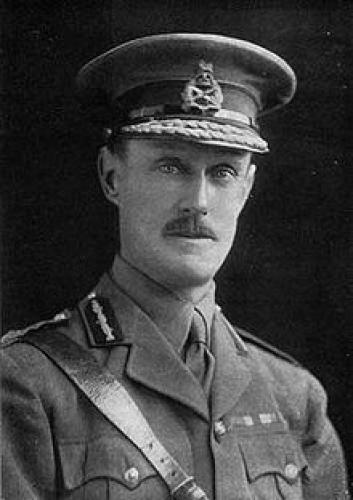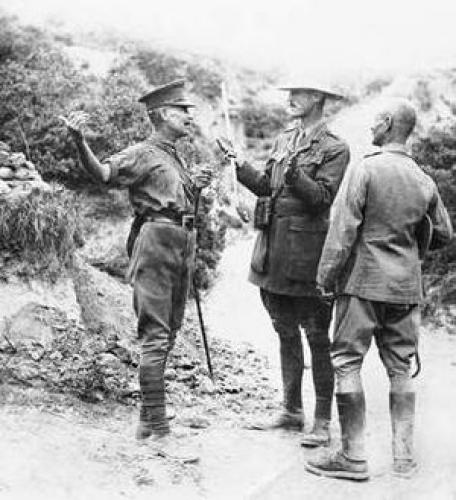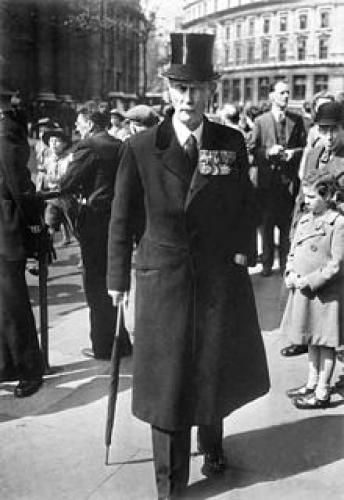156 Godley Street Lower Hutt, street scene 2018
Reason for the name
This Lower Hutt Street was named in honour of General Sir Alexander John Godley, GCB, KCMG (4 February 1867 – 6 March 1957). He was a senior British Army officer. He is best known for his role as commander of the New Zealand Expeditionary Force and II Anzac Corps during the First World War.
Born in Gillingham in England, Godley joined the British Army in 1886. He fought in the Boer War and afterwards served in a number of staff positions in England. In 1910 he went to New Zealand as Commandant of the New Zealand Military Forces. Promoted to temporary major general, he reorganised the country's military establishment. Following the outbreak of the First World War, the New Zealand government appointed him as commander of the New Zealand Expeditionary Force, which he led for the duration of the war.
During the Gallipoli campaign, Godley commanded the composite New Zealand and Australian Division, before taking over command of the Australian and New Zealand Army Corps for the final stages of the campaign. Promoted to lieutenant general, he was given command of II Anzac Corps in 1916. He led the corps for most of its service on the Western Front. Regarded as a cold and aloof commander, his popularity was further dented in October 1917 when he insisted on continuing an offensive in the Ypres salient when weather and ground conditions were not favourable. His corps suffered heavy losses in the ensuing battle. In 1918, II Anzac Corps was re-designated as British XXII Corps and he led it for the remainder of the war.
After the war, Godley spent time in occupied Germany as commander of firstly the IV Corps and then, from 1922 to 1924, the British Army of the Rhine. In 1924 he was promoted to general and was made General Officer, Commanding, of England's Southern Command. He was appointed a Knight Grand Cross of the Order of the Bath in 1928 and was Governor of Gibraltar for five years until his retirement in 1933. During the Second World War he commanded a platoon of the Home Guard. He died in 1957 at the age of 90.
Author: Poppy Places Trust
Commandant of the New Zealand Military Forces
Godley was a colonel and serving on the staff of 2nd Division when, in 1910, he accepted the position of commandant of the New Zealand Military Forces, as the New Zealand Army was then known. He had some reservations about his new appointment; he had been in line for command of an infantry brigade and was concerned that being posted to remote New Zealand would be detrimental to his career. He arrived in New Zealand to take up his duties in December 1910.
Promoted to temporary major general, Godley, together with fourteen British Army officers seconded to the New Zealand Military Forces, was tasked with reorganising and instilling professionalism in the military establishment of the country. Compulsory military training had recently been introduced by the government but with little thought as to its implementation. In refining the New Zealand Military Forces, Godley drew heavily on the recommendations of Lord Herbert Kitchener, who had visited New Zealand earlier in the year on an inspection tour.
Godley established the Territorial Force, which replaced the outdated and recently disbanded Volunteer Force. He organised the structure of the New Zealand Military Forces into four military districts, with each district to be capable of raising an infantry and a mounted brigade. The districts had a specified number of battalions and regiments organised along the lines of the British Army. He also formed the New Zealand Staff Corps, which provided a professional body of officers to train and administer the Territorial Force. The quality of small arms and other personal equipment provided to the country's military personnel were improved and orders placed for new artillery pieces and machine-guns.
By 1914 the Territorial Force had some 30,000 men involved in divisional level training camps; two years previously, the manpower and logistical constraints of the force was such that only battalion level camps could be achieved. When General Ian Hamilton, the Inspector General of Overseas Forces, visited New Zealand in 1914, he was impressed with the level of preparedness of the country's military. This reflected positively on Godley's work, and he was appointed Knight Commander of the Order of St Michael and St George the same year.
From 1912, Godley began putting plans in place for the rapid deployment of a New Zealand Expeditionary Force (NZEF) in the event of war in Europe. He anticipated that Imperial Germany would be the likely enemy and envisaged deployment to either Europe or possibly Egypt, to counter the likely threat to the Suez Canal in the event Turkey aligned itself with Germany. He envisioned the expected deployment would be co-ordinated with an Australian Imperial Force (AIF) and liaised with the Australian Chief of General Staff, Brigadier General Joseph Gordon, and the possibility of a composite division was discussed. The question of Germany's possessions in the South Pacific was also raised, and it was agreed that New Zealand would have responsibility for German Samoa, while Australia dealt with German New Guinea. The arrangements Godley put in place for deployment for the NZEF were soon put to the test, for when the First World War began, a New Zealand occupation force was quickly assembled to occupy German Samoa.
First World War
The New Zealand government authorised the formation of the NZEF for service in the war in support of Great Britain, with Godley, having relinquished his position as commandant of the New Zealand Military Forces to Major General Alfred William Robin, as its commander. Godley would retain command of the NZEF for the duration of the war, making regular reports to James Allen, the New Zealand Minister of Defence. By October 1914, the NZEF consisted of 8,500 men and, along with Godley, embarked from Wellington for Europe. The NZEF was intended for service on the Western Front but was diverted to Egypt while in transit, following the entry of Turkey into the war. In Egypt, the NZEF underwent an intensive period of training under Godley's supervision. Despite his strict approach to training and discipline, he was a relatively enlightened commander for his time; he discreetly established drinking canteens and venereal disease treatment centres for his men.
Gallipoli
Prior to the start of the Gallipoli Campaign, Godley was made commander of the New Zealand and Australian Division, a composite formation of infantry brigades of the NZEF and the AIF. His new command was one of two infantry divisions of the newly formed Australian and New Zealand Army Corps, commanded by General William Birdwood.
Although an extremely competent administrator, there were reservations within the New Zealand government following Godley's appointment as commander of the division. Allen, although publicly supportive of Godley, privately believed an alternative commander should be found after the division completed its training. Godley was a distant and remote divisional commander, not popular with most soldiers of his command. He also favoured the professional officers of the NZEF, most of whom were seconded from the British Army, over those drawn from the Territorial Force.







